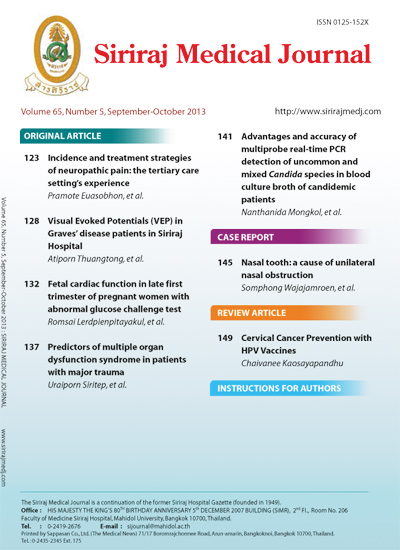Visual Evoked Potentials (VEP) in Graves’ Disease Patients in Siriraj Hospital
Keywords:
Visual evoked potentials, Graves’ disease, subclinical optic neuropathyAbstract
Objective: To evaluate the visual evoked potentials (VEP) in Graves’ disease patients in order to reveal the possible presen- tation of subclinical optic neuropathy.
Methods: Forty-seven Graves’ disease patients without symptoms of optic neuropathy were enrolled. Flash visual evoked potentials (F-VEP) and Pattern visual evoked potentials (P-VEP) were evaluated. Comparison of VEP with normal values was done, between the groups with and without the presentation of eye sign(s) and also among the groups that had differ- ences in thyroid hormone function.
Results: The mean F-VEP amplitude and latency were 17.56±6.20 microvolts (μV) and 114.02±14.92 milliseconds (ms), respectively. The mean P-VEP amplitude and latency were 10.82±4.88 μV and 99.67±5.87 ms, respectively. These values were within normal values. Only the latency of P-VEP was increased significantly (P<0.001) when compared between the groups with (101.81±5.70 ms) and without eye signs (97.43±5.21ms) and it also increased significantly (P=0.033) when compared with normal values. The hyperthyroid group also had a significant increase in the latency of P-VEP when compared to other groups (P=0.002).
Conclusion: Increase in the latency of P-VEP should be sought for and reminded the clinician to conduct close follow-up of this as an early sign of optic neuropathy, especially in the patients with eye manifestation.
Downloads
Published
How to Cite
Issue
Section
License
Authors who publish with this journal agree to the following conditions:
Copyright Transfer
In submitting a manuscript, the authors acknowledge that the work will become the copyrighted property of Siriraj Medical Journal upon publication.
License
Articles are licensed under a Creative Commons Attribution-NonCommercial-NoDerivatives 4.0 International License (CC BY-NC-ND 4.0). This license allows for the sharing of the work for non-commercial purposes with proper attribution to the authors and the journal. However, it does not permit modifications or the creation of derivative works.
Sharing and Access
Authors are encouraged to share their article on their personal or institutional websites and through other non-commercial platforms. Doing so can increase readership and citations.











